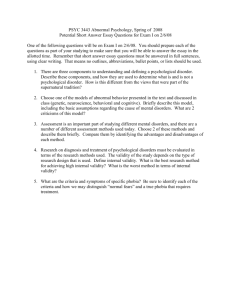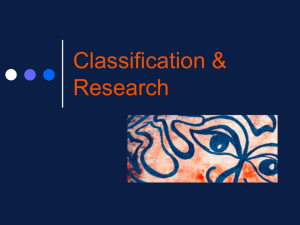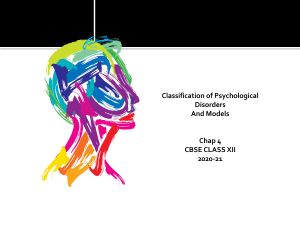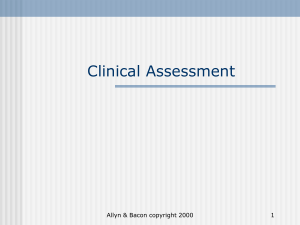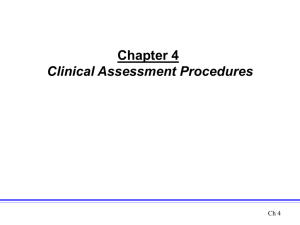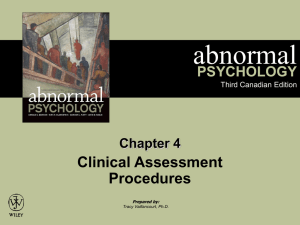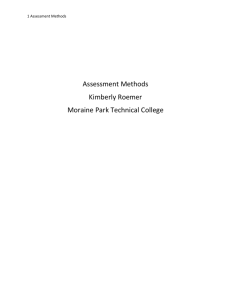abnormal psychology ch3
advertisement
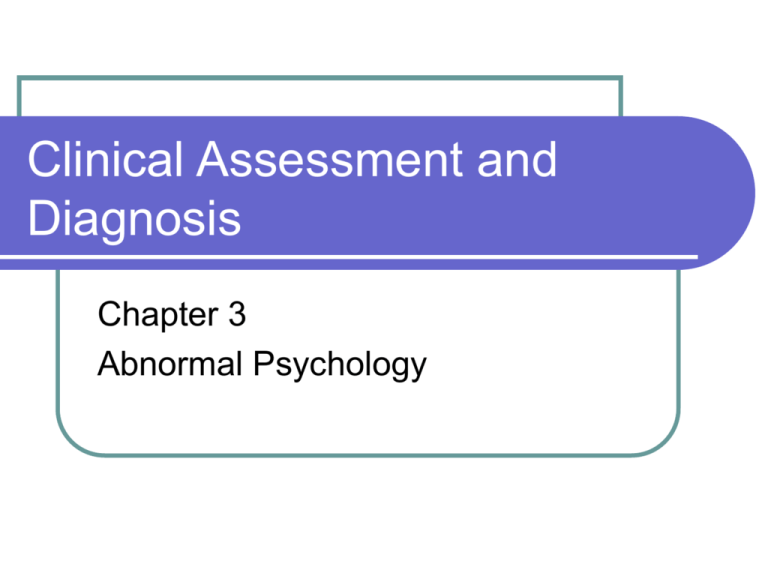
Clinical Assessment and Diagnosis Chapter 3 Abnormal Psychology Clinical Assessment Protocols used for evaluation and measurement Assessing/diagnosing psychological disorders Getting Started What brings the client to the provider? Discussion of the presenting problem and the client’s history Concepts in Assessment Reliability: the consistency of measurement Validity: does it measure what it is meant to measure? Standardization: comparing individuals with similar persons; asking questions in a consistent manner The Clinical Interview Current and past behavior Emotions and attitudes A detailed history The presenting problem Significant life events Childhood information and family history Sexual development Religious beliefs/cultural background Educational history The Mental Status Exam 1. Appearance and Behavior- motor behavior, movements 2. Thought process- rate/flow of speech; coherence; any evidence of delusions/hallucinations? 3. Mood and Affect- what is the mood and is it consistent? What is affect like and is it appropriate? The Mental Status Exam Intellectual functioning: vocabulary, use of language; general sense of cognitive abilities Sensorium: Awareness of immediate surroundings; Oriented x3? (Person, place, time) Issues to Consider Is the client presenting the central issues? Are there other issues the client sees as unimportant? Establishing rapport Confidentiality: Scope and limitations Other Clinical Interviews Interviews or instruments specific to a particular disorder or concern: to learn the specific symptoms and their severity Anxiety Disorders Interview Schedule- questions specific to compulsions and obsessions Eating Disorder interviews/scales Physical Exam Physical problems may mimic psychological disorders Thyroid issues Brain lesions/tumors Dementia Drug induced conditions Behavioral Assessments Observing the client in specific contexts, in real life settings or simulated situations Asking others to fill out behavior “checklists” Often used with children: school and home visits Self-Monitoring Clients may be asked to keep a log of their thoughts/behaviors When the behaviors occur in private To note frequency, severity, and “triggers”; for self-reflection Overview of Psychological Tests Projective Tests Personality Inventories Intelligence Tests Neuropsychological Tests Projective Tests Client “projects” thoughts and feelings- to reveal unconscious thoughts Rorschach (ink blot test) Thematic Apperception Test (TAT) Critique: limited reliability/validity; not directly linked to the process of diagnosis Personality Inventories Comparing an individual’s score with the pattern of responses of those with diagnosed psychological conditions MMPI: Minnesota Multiphasic Personality Inventory 567 true/false questions MMPI Sample Questions: I often think I’m being followed I am often happy for no reason Sometimes I get so mad I want to swear I sometimes throw up after meals Evil spirits possess me at times MMPI: Scales Clinical Scales: 1: Hypochondriasis 2: Depression 3: Hysteria (Conversion) 4: Psychopathic Deviant 5: Masculinity/Femininity 6: Paranoia 7: Psychastenia (Anxiety) 8: Schizophrenia 9: Hypomania 0: Social Introversion Lie Scale; Infrequency Scale (to detect random answers); Defensiveness Scale MMPI Results in a “code type” Looking at answers left blank Excellent reliability, good validity Neuropsychological Tests Neuroimaging CAT scans/MRI: to assess brain damage and to look at the structures of the brain PET scans: the functioning/activity of the brain EEG: brain waves Issues in Diagnosis Diagnostic and Statistical Manual Reliability/Validity Some diagnoses have greater reliability/validity than others Personality Disorders tend to have lower reliability Diagnostic and Statistical Manual I and II were not widely used; lacked precision, were unscientific, and had little reliability DSM III: 1980: more atheoretical; more precise descriptions; reliability/validity studies Axes 1-5 Five “Axes” or Dimensions Axis I: The Disorder Axis 2: Personality Disorder/MR Axis 3: Medical Conditions Axis 4: Problems: Psychosocial & Environmental Axis 5: Global Assessment of Functioning (Scale) Critique of the DSM Culturally sensitive? Stigma of labels “Fuzzy” categories and co-morbidity Categories based more on history than current science? (Kraeplin’s dichotomy) DSM-V In progress Various workgroups: clinicians and researchers Revisions/new additions
